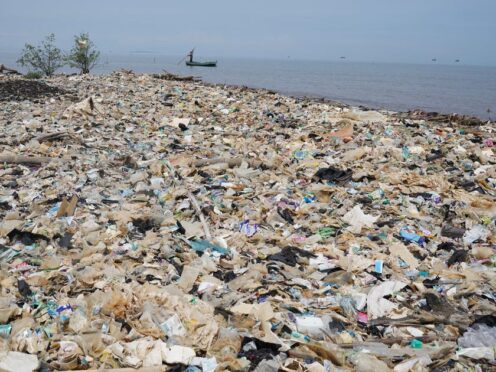
Plastic left to float in seawater may turn it cloudy potentially releasing toxic chemicals into the water, and could do the same in birds’ stomachs, an expert has said.
When left in the water for six months, the pristine plastic also appeared to cause a kind of scum to form on the surface, turning the mix into a “soup”.
Based at the Natural History Museum, Dr Joby Razzell Hollis, whose work focuses on the impact of plastic pollution on seabirds, said it was “shocking” to see the impact the plastic pellets had on the water in the ongoing study.
He told the PA news agency: “We’re really interested in seeing how the plastic is changing but also what the plastic is releasing into the water.
“And it definitely is, because not only have we seen that some of this plastic has visibly discoloured over time – it has turned yellow as it’s been exposed to sunshine.
“But also some of the plastic that’s been floating in water, after six months that water has become kind of cloudy, and you can see there is a kind of scum on the surface.
“So these plastics are releasing something into the water as they degrade, and that’s kind of similar to what you would expect to see happening in the ocean.
“But also if you imagine when you put those plastics into a seabird’s stomach, and you expose them to acids that could potentially be different kinds of chemicals that they’re releasing as well.
“So it’s clear that these plastics are not inert, they are changing over time, they are interacting with their environment and they’re releasing something.
“We are really curious to find out exactly what that is and then compare it to the list of known chemicals of emerging concern, or things that are potentially toxic.”
Some 44% of seabird species are known to eat plastic, and some species are particularly badly affected, causing malnutrition and new diseases like plasticosis, experts say.
Dr Hollis said: “The plastic they have in their stomach is almost certainly too large to pass and won’t break down easily.
“But the problem is that from a chemical perspective, the stomach acid may be enough to release chemicals, small amounts of chemicals, but even a small amount can be potentially quite toxic. So we really want to try and figure out how that process is occurring.”
Dr Hollis hopes that by measuring the different types of plastic they eat, as well as the size, shape and colour, he will be able to understand why seabirds mistake plastic pollution for food, and what it is about plastic that causes the most harm when ingested.
The researchers have found that flesh-footed shearwater is almost exclusively eating low-density plastics like polyethylene, and this is likely because this species only forages near the ocean surface where such plastics float.
The researchers are just finishing the six-month study of deliberately degrading plastic in artificial seawater to see how it breaks down and releases potentially harmful chemicals over time in the ocean.
Speaking on what they have found so far, Dr Hollis said: “I sort of jokingly referred to it as plastic soup. It doesn’t really look like clean water any more.”
He added: “To see the fact that the water is visibly changing was quite shocking.”
Dr Hollis was speaking ahead of the launch of the Birds Brilliant And Bizarre exhibition on Friday at the Natural History Museum.
The exhibition tells the story of birds as the ultimate survivors who as descendants of the dinosaurs have conquered every continent on Earth thanks to their ingenious behaviour and adaptations.

Enjoy the convenience of having The Sunday Post delivered as a digital ePaper straight to your smartphone, tablet or computer.
Subscribe for only £5.49 a month and enjoy all the benefits of the printed paper as a digital replica.
Subscribe